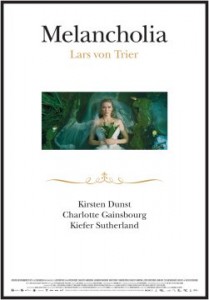These days Lars Von Trier is mostly remembered for his unseemly outburst at the Cannes Film Festival. His new film, Melancholia, has been lost in the post scandal shuffle — even with Kirsten Dunst’s Best Actress win at the festival. However, the most interesting aspect about the film is that it quietly launched a controversial way of viewing new movies. Before the film was to be released in theaters on November 11, the film was made available on video on demand first. On October 7, consumers were allowed to view on iTunes, Amazon, Vudu, Playstation and Zune.
Melancholia is not the only film to go the VOD route. A lesser known William Monohan film named London Boulevard did a VOD release before opening up on larger screens. Before Tower Heist hit theaters, Universal wanted to make it available on VOD as well. However, the outcry of the National Association of Theatre Owners actually made Universal back down from those plans.
The plot behind Melancholia, doesn’t necessarily seem like it would translate to a smaller screen. Essentially, the film follows a bride on her wedding day just as the world is about to die. Much of the buzz around the film hasn’t only been for the performances, but also for the film’s cinematic imagery. Since viewing the film in a theater would probably enhance the the movie-going experience, what was the purpose behind releasing this indie film on VOD first? Especially since once the film reaches theater, the film is no longer available on VOD.
Melancholia’s VOD release may simply be about the marketing. On the surface, the movie’s reputation has a lot going against it. Von Trier is a controversial filmmaker and the premise of the film might be a little too artsy for the average moviegoer. Many critics say that the film could have captured the Palm D’ Or if not for Von Trier’s press conference debacle. For those same reasons, a more subtle marketing approach is all the more important here. In order to build momentum for the film, people that view the film on VOD can help spread positive word of mouth about the film, especially through the internet, which in turn, may boost theater ticket sales.
Another argument can be made that VOD actually widens the film’s distribution. An indie film like this will only find billing at a handful art house style theaters, which at times, can be out of the way for those who don’t happen to live by the city limits. Instead of having to trek far away to see a much desired indie, you can purchase it right on your computer. VOD might also draw a wider audience, especially from those not normally inclined to see indie films.
The battle over VOD versus going to a theater has been one that’s been going on for some time. There’s something to be said about enjoying a film in the comforts of your own home. It’s more cost effective, comfortable, easy and accesible. But the truth is cinema has always been about transporting people to another world in a very literal sense. Nothing can ever really compare to a sitting in a dark theater and watching a story unfold on a movie screen. But once we completely embrace the VOD route, as the National Association of Theatre Owners have mentioned, we’re going to change the concept of cinema as we know it.

